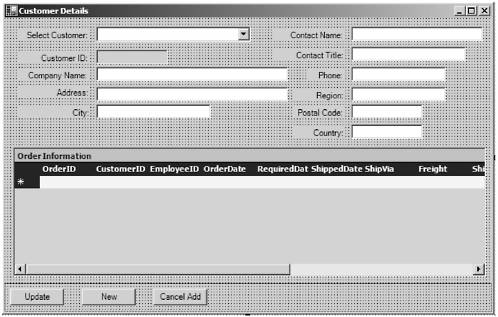Using Web Services with Web Forms Clients Web Forms clients to Web Services sounds redundant. Why not just access the data directly in the Web Form? It is transparent to the user anyway, right? Yes, but you are missing the point of Web Services. What if a Web Service existed that was published by one of your company's vendors ? The Web Service enabled you as a programmer to access data about your company's order status with this vendor. You can present this data in any way you wish. Suppose you had a requirement to build a robust Windows interface for use in-house, but needed a web interface as well for your road warriors to use. By using the Web Service you can build both interfaces and they will conform to the business rules defined by the vendor. To keep it simple, we will use the same Web Form we used in the previous chapter. We will merely change the code to use the Web Service we just built for our Windows Form. To refresh our memories, Figure 10.22 shows the form we will use from ADOBook09-02. Figure 10.22. The Web Form for the Web Service.  For this project, create a new project in the same solution we have been using, with the Web Service and the Windows Form in it. Next, go to Windows Explorer and copy the Web Form from ADOBook09-02 into ADOBook10-03. Now in the Solution Explorer, include the form in the project using the Show All Files button. (We've done this before, right?) Now add the web reference as we did in the Windows Forms project. It's the same process. Next, make this the startup project and the Web Form the startup form. You can delete the default Web Form that was created when we created the project. Now let's do something drastic. Open the Web Form in Design mode. Delete the DataAdapters and the Connection object. Add a new DataSet as a dsOrders type the same way we did in the Windows Form. Now go through the code and change the references to dsCust1 and dsCustList1 to reference the classes from the Web Service, just like in the Windows Form. There is one change: The Orders table is no longer in dsCust1. It is now in dsOrders1. You should change the code to reflect this. Now search for each reference to the DataAdapters. We must change these to get the data from and update it to the Web Service. The whole program follows . We have already done all of this so I don't think it needs much explanation. Private mWebSvc As localhost.CustomersOrders = New localhost.CustomersOrders() Private Sub Page_Load(ByVal sender As System.Object, ByVal e As System.EventArgs) Handles MyBase.Load If Not IsPostBack Then Session("IsAdding") = False DsCust1 = New localhost.dsCust() Session("dscust1") = DsCust1.Copy DsOrders1 = New localhost.dsOrders() Session("dsorders1") = DsOrders1.Copy DsCustList1 = New localhost.dsCustList() Session("dscustlist1") = DsCustList1.Copy Else DsCust1 = CType(Session("dscust1"), localhost.dsCust).Copy DsOrders1 = CType(Session("dsorders1"), localhost.dsOrders).Copy End If End Sub Private Sub DropDownList1_SelectedIndexChanged(ByVal sender As System.Object, ByVal e As System.EventArgs) Handles DropDownList1.SelectedIndexChanged If Me.IsPostBack Then Session("selIndex") = DropDownList1.SelectedIndex DsCust1.Merge(mWebSvc.GetCustomer(DropDownList1.SelectedItem.Value)) DsOrders1.Merge(mWebSvc.GetOrders(DropDownList1.SelectedItem.Value)) Me.DataBind() End If End Sub Private Sub Page_PreRender(ByVal sender As Object, ByVal e As System.EventArgs) Handles MyBase.PreRender If IsPostBack Then DsCustList1 = Session("CustList") DropDownList1.DataBind() DropDownList1.Items(Session("selIndex")).Selected = True Else DsCustList1.Merge(mWebSvc.GetCustomerList()) Session("CustList") = DsCustList1 DropDownList1.DataBind() End If Session("dsCust1") = DsCust1.Copy End Sub Private Sub ClearScreen() TextBox1.Text = "" TextBox3.Text = "" lblError.Text = "" End Sub Private Sub Button4_Click(ByVal sender As System.Object, ByVal e As System.EventArgs) Handles Button4.Click DsCustList1.Clear() DsCustList1.Merge(mWebSvc.GetCustomerList()) Session("CustList") = DsCustList1 DropDownList1.DataBind() End Sub Private Sub DataGrid1_PageIndexChanged(ByVal source As Object, ByVal e As System.Web.UI.WebControls.DataGridPageChangedEventArgs) Handles DataGrid1.PageIndexChanged DsCust1 = CType(Session("dscust1"), localhost.dsCust).Copy DataGrid1.CurrentPageIndex = e.NewPageIndex DataGrid1.DataBind() End Sub Private Sub DataGrid1_EditCommand(ByVal source As Object, ByVal e As System.Web.UI.WebControls.DataGridCommandEventArgs) Handles DataGrid1.EditCommand DataGrid1.EditItemIndex = e.Item.ItemIndex DataGrid1.DataBind() End Sub Private Sub DataGrid1_UpdateCommand(ByVal source As Object, ByVal e As System.Web.UI.WebControls.DataGridCommandEventArgs) Handles DataGrid1.UpdateCommand Dim i As Integer Dim dsTemp As localhost.dsOrders Try ' This only works if the order of the grid columns is the same as the ' order of the columns in the DataTable. For i = 3 To e.Item.Cells.Count - 1 If Not DsOrders1.Orders.Columns(i - 3).ReadOnly Then DsOrders1.Orders.Rows(e.Item.ItemIndex)(i - 3) = CType(e.Item.Cells(i).Controls(0), TextBox).Text End If Next dsTemp = DsOrders1.GetChanges(DataRowState.Modified) DsOrders1.Merge(mWebSvc.UpdateOrders(dsTemp)) Catch errobj As Exception lblError.Text = errobj.Message & vbCrLf & errobj.StackTrace Exit Sub End Try DataGrid1.EditItemIndex = -1 DataGrid1.DataBind() End Sub Private Sub DataGrid1_CancelCommand(ByVal source As Object, ByVal e As System.Web.UI.WebControls.DataGridCommandEventArgs) Handles DataGrid1.CancelCommand DataGrid1.EditItemIndex = -1 DataGrid1.DataBind() End Sub Private Sub DataGrid1_DeleteCommand(ByVal source As Object, ByVal e As System.Web.UI.WebControls.DataGridCommandEventArgs) Handles DataGrid1.DeleteCommand Dim dsTemp As localhost.dsOrders Try DsOrders1.Orders.Rows(e.Item.ItemIndex).Delete() dsTemp = DsOrders1.GetChanges(DataRowState.Deleted) DsOrders1.Merge(mWebSvc.UpdateOrders(dsTemp)) Catch errobj As Exception lblError.Text = errobj.Message & vbCrLf & errobj.StackTrace Exit Sub End Try DataGrid1.DataBind() End Sub As you can see, we are using the same web methods we used in the Windows Forms project, combined with the techniques we use for Web Forms, such as saving session state, and so on. The great thing is that your web programmers do not have to know any SQL at all! Just document your Web Service well and give them what they need. |